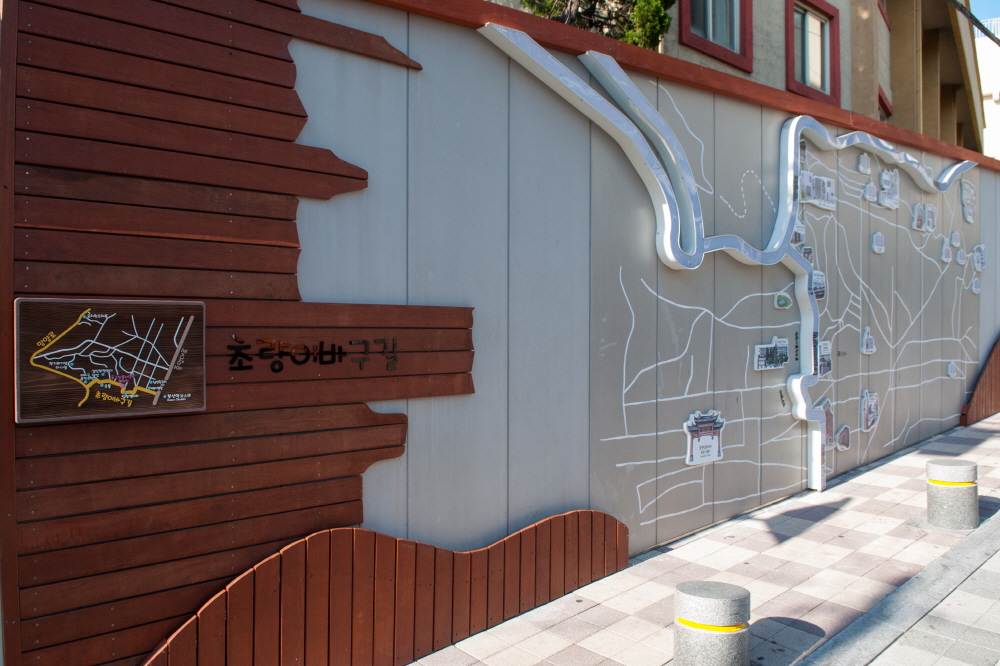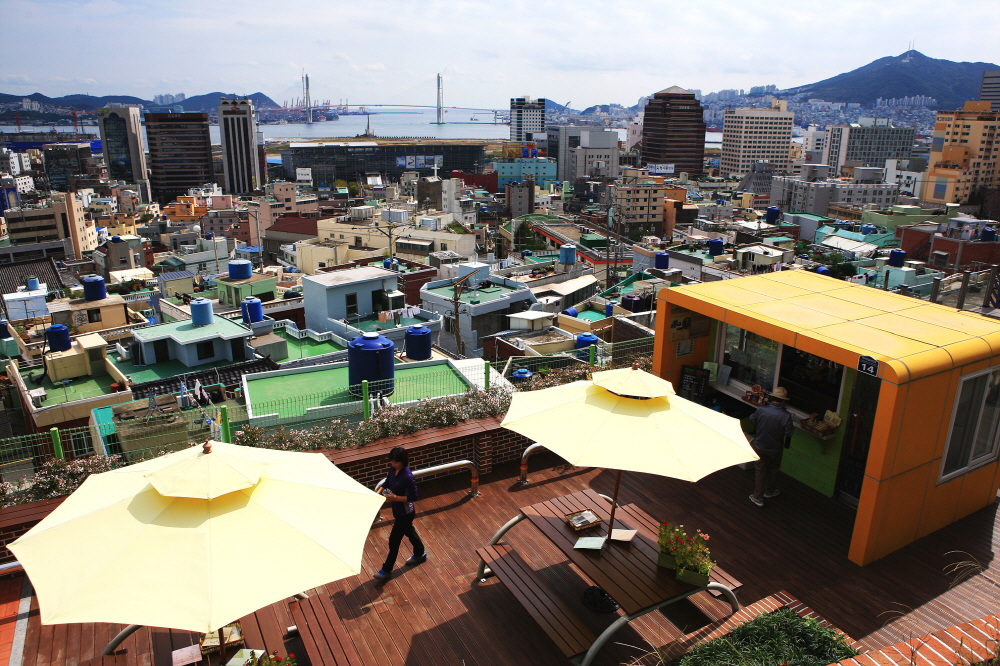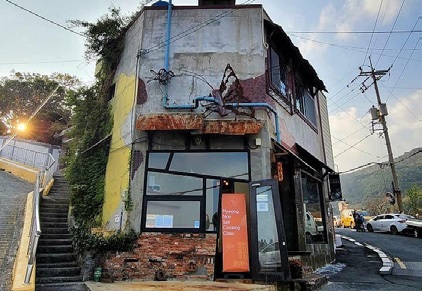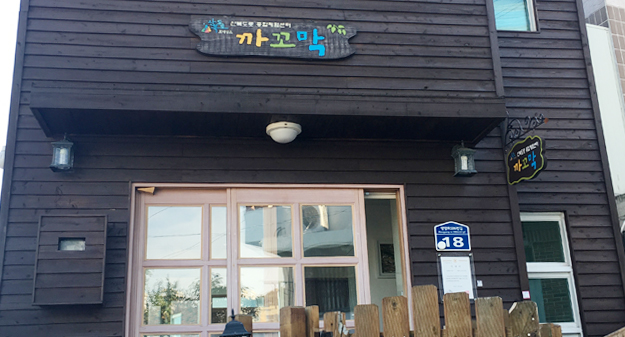Ibagu-gil Road Routes
Ibagu-gil Road Routes
Time Travel through Alleys for Stores Left by Time and People of the Past
Namseon Storage (Site) → Former) Baekje Hospital → Damjang (Wall) Gallery → Dong-gu Inmulsa (Famous Figures) Wall → Ibagu Stop → 168 Do.Si.Rak.Guk → 168 Steps → Well Site → 168 Monorail → Kim Min-bu Observatory → 6.25 Makgeolli → Ibagu Chungjeonso (House) → Dangsan Shrine → Ibagu Gongjakso (Studio) → Jang Gi-ryeo Deo Nanum Center → Skyway Parking Lot → Yu Chi-hwan Post Box → Kkakkomak → Kkakkomak Café
Choryang Ibagu-gil Road Route Experience Program
1


- Namseon Storage (Site)
- Address53, 13beon-gil, Choryang-ro, Dong-gu, Busan
- This was the first storage facility in Busan. It was also called Bukseon Storage for bringing things from Hamgyeong-do as well as Myeongtae Storage for storing myeongtae (walleye Pollack). Through the Gyeongbu Line, things in Namseon Storage were distributed nationally. It was removed over time and only fences remain.
2


- (Former) Baekje Hospital
- Address16, 209beon-gil, Jungang-daero, Dong-gu, Busan
- Established in 1922 by a Korean, this was the first modern individually -owned general hospital in Busan with a Western-style five-story building. Later, it served as the consulate for Taiwan, a law-enforcement office, and a Chinese restaurant.
3
4


- Dong-gu Inmulsa (Famous Figures) Wall
- Address53, Choryangsang-ro, Dong-gu, Busan
- This place reflects famous figures from Dong-gu who have led Korean modern history and discusses the future of Dong-gu. The wall consists of an introductory portion with poems and pictures depicting life on the Sanbok Road, followed by the introduction of people living in Dong-gu, Korean Wave stars from Choryang Elementary School, and what it is like living in Choryang, Dong-gu. Additionally, the wall along Choryang Elementary School symbolizes the history and future of Dong-gu as the origin of Busan. Numerous popular figures produced by the elementary school (opened in 1937) and Dong-gu are showcased on the wall. A school supply shop selling tteokbokki and other popular children’s food in the past still remains here
5
6


- 168 Do.Si.Rak.Guk
- Address191, Yeongcho-gil, Dong-gu, Busan
- Before exploring Ibagu-gil Road, visitors may want to eat a delicious lunch box, sirakguk (soy bean paste soup with dried radish leaves), and a ground cup of coffee. The restaurant refers to the combination of 168 steps, dosirak (lunch box), and sirakguk
7
8


- 168 Steps
- Address9-2, 191beon-gil, Yeongcho-gil, Dong-gu, Busan
- These are steep steps that seem difficult to finish climbing, but, at the top of the steps, visitors can see a gorgeous view of the Port of Busan. As a popular attraction, they symbolizes the history of Dong-gu and the life of people living in Dong-gu, the origin of Busan. It is the fastest shortcut to reach Sanbok Road from the Port of Busan (Busan Station). Placed in front of the gates of many homes, the steps are readily scaled for senior or disabled visitors through a 60m-long convenience facility called 168 Monorail
9


- 168 Monorail
- Address9-2, 191beon-gil, Yeongcho-gil, Dong-gu, Busan
- This 60m-long monorail (with 33 degree incline) was built for residents that would difficulty in climbing the 168 Steps. Once on board the monorail, visitors can enjoy the view of the Port of Busan and the outstanding landscaping of Sanbok Road. There is a stop between the 168 Steps so that visitors may get off before reaching the top of the 168 Steps.
10


- Kim Min-bu Observatory
- Address14, 26beon-gil, Yeongchowit-gil, Dong-gu, Busan
-
This is an observatory in which visitors can appreciate the poet Kim Min-bu’s poem Waiting Heart (which expresses the heart of a person waiting for somebody who can’t come) and was used for a popular classical song with the same title). Initially, the observatory was frequented only by poets and novelists remembering Kim Min-bu. But once word got out that the view from the observatory reflects the sadness expressed by the classical song Waiting Heart and another poem called Cracks, local residents and other tourists began to populate the observatory as well.
Additionally, visitors can enjoy beverages or a cup of coffee in a small cafeteria (160m2) with colorful chairs that replaced three or four empty houses on Sanbok Road. Through the observatory, visitors can look out over homes tightly spaced next to one another on Sanbok Road with the backdrop of the Port of Busan. Colorless homes and disorderly electrical wires produce a unique pathos.
11
12


- Ibagu Chungjeonso
- Address25, Yeongchowit-gil, Dong-gu, Busan
- This is designed to let visitors to Ibagu-gil Road fill in their own stories. It visually expresses a board or tin house reflecting the life of refugees from the Korean War. Serving as a travel information center, recreational space, guesthouse, and experience facility, it is operated by local senior residents as part of the Senior Jobs Project. It also displays and sells leather crafts; visitors can also participate in an on-site leather craft experience program. From the house, visitors can look out over the splendid view of the Port of Busan along with Busan Station and Bukhangdaegyo Bridge while sharing new memories and stories with others.
13


- Dangsan Shrine
- Address13, 478beon-gil, Mangyang-ro, Dong-gu, Busan
-
This is a place to hold ancestral rites in lunar March and September directed to the Dangsansin (deities of Dangsan) for the peace and prosperity of the Choryang village. Built in April 1993, the shrine serves the Dangsansin (Dansan Grandfather and Dangsan Grandmother) as the protective deities of the village. Rebuilt in April 1993, two buildings in the shrine are placed next to each other under a 100-year-old nettle tree. It is not clear when the Dangsan rite began just as it is not clear when local sacrificial rites began. But rites here have been held for a century. They are local community rites to wish for the abundance and peace of the village.
Held in Choryang 2-dong, Dangsan rites take place around 7 a.m. on March 16th and September 16th (lunar) at the Dangsan Grandfather Shrine and Dangsan Grandmother Shrine. The organizer of the rites is believed to have taken over the duties from his mother. Dangsan rites are our cultural heritage that has been preserved in the turbulence of modern Korean history. They were suppressed during the Japanese rule as part of Japan’s policies to get rid of Korean heritage. They were also shunned during the Saemaeul (New Community) Movement as superstitious activities. But they have survived to this day and developed into local events participated in by local residents. On the days rites take place, local residents gather together and confirm their friendship with each other. As such, these rites contribute to unifying the village and strengthening the communal spirit.
14


- Ibagu Gongjakso (Studio)
- Address14-13, 486beon-gil, Mangyang-ro, Dong-gu, Busan
- This is space for collecting and displaying stories associated with the Korean War, Koreans who fought in the Vietnam War, and Sanbok Road. It embraces the lives of senior residents who have lived modern Korean history and their memories. It is a vibrant space where important materials are continually collected to give visitors perspectives of our past and future. The place also offers diverse exhibitions, lectures, cultural events, and education and experience programs, striving for sustainable communication in local communities
15


- Jang Gi-ryeo Deo Nanum Center
- Address48, Yeongchowit-gil, Dong-gu, Busan
- Called Korea’s Albert Schweitzer, Dr. Jang Gi-ryeo established the Blue Cross Medical Insurance Association, the origin of medical insurance in Korea, and practiced the importance of sharing with poor neighbors. The center was created to commemorate him. Dr. Jang built tents for an evangelical hospital where he offered medical treatments for refugees from the Korean War and sick wayfarers free of charge. Never owning his own home during his life, Dr. Jang dedicated himself to medical and volunteer activities on behalf of the poor. The center to commemote Dr. Jang’s spirit and practice of “deo nanum” (more sharing) consists of four rooms (Health Sharing Room, Storybook Room, Heart Sharing Room, and Small Library), operating diverse programs to promote the health of residents and support their cultural needs.
16


- Skyway Parking Lot
- AddressMangyang-ro, Dong-gu, Busan (Choryang 6-dong)
(behind the Busan Computer Science High School) - The parking lot on Mangyang-ro (Road) was built for the convenience of residents and tourists as well as for pedestrians’ safety and smooth transportation as the relatively narrow Sanbok Road is populated with many tourists, local residents, and vehicles. Located at the foot of the road, the parking lot is connected to a 200m-long pedestrian pathway and an observatory with a rest area. From the parking lot, visitors can see the view of Sanbok Road with houses tightly placed next to each other against the backdrop of the Port of Busan. - Parking Capacity: 58 vehicles (53 cars, 3 spaces reserved for the disabled, and 2 buses)
17


- Yu Chi-hwan Post Box
- Address2, 580beon-gil, Mangyang-ro, Dong-gu, Busan
- This is a place to commemorate Cheongma (pen name) Yu Chi-hwan while overlooking the Port of Busan. Located in the spot on the Sanbok Road with the most outstanding view of the local landscape around, it commemorates Yu Chi-hwan, who served as the Principal of Gyeongnam Girls’ High School and passed away in the aftermath of an unfortunate traffic accident near Jwacheon-dong. He was a giant of modern Korean literature who loved Busan. The place consists of an outdoor performance hall on the first floor, a Poet’s Room on the second floor, and an observatory on the third floor. The building resembles the World’s first camera Opticura. It is a cultural community space where painting exhibitions and book concerts take place with visitors overlooking the landscape of Sanbok Road. The observatory connected to Sanbok Road houses a post box symbolizing the longing that delivers mail placed into a year later to recipients.
18


- Kkakkomak
- Address18, 596beon-gil, Mangyang-ro, Dong-gu, Busan
- Meaning “mountain slope” in the Gyeongsang-do dialect, Kkakkomak expresses a board house representing the life of refugees during the Korean War. It is not only an information center for visitors to Choryang Ibagu-gil Road, but also a guesthouse in which visitors listen to cultural and historical stories from a senior storyteller. Offering diverse on-site programs, it is operated by local residents and displays and sells products made by local enterprises. Along with the nearby Kkakkomak Observatory and Kkakomak Café, visitors can enjoy rest while appreciating the view of the Port of Busan and Sanbok Road.






